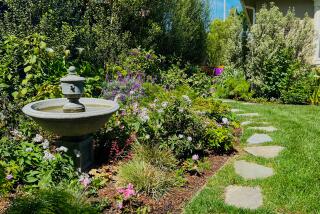Oh, the places you’ll grow!
is a sad, sad sight
when everywhere we look,
each garden that we see
is from the copycat book.
We wish we would find
clumps of snazzle-poke plants,
or shrubs of snick-berries
or a tree that grows pants!
“We want that!” we all shout.
“Something different, something new!
But how do we get it?
Where? Why? What? And who?”
YOU can scan magazines, coffee-table books and how-to encyclopedias, fervently seeking garden inspiration, but the best ideas just may sit right there on your kid’s shelf: Dr. Seuss left landscapes that are simple genius. They are imbued with fantastic twists and hypnotic twirls, with fuzzy trees, spindly shrubs and goofy groundcovers. The gardens he rendered are at once strange and comical and then, too, comforting and sweet. You would be happy to sit in a garden like his, to read your books, to sip your gobo tea. You would and you could.
And it needn’t be a large garden. In fact, it might be better as a garden room, a getaway space, a secret corner of solace. It would need only enough yard to allow for some mounds, for a Dr. Seuss garden has but one rule: Hills and bumps are not a “could” but a “should.” Otherwise, it’s no good.
After the bumps are in place, consider the plants. Ethan Prall-Freedman of Brentwood, 7 years old and not yet married, suggests, “I think you would want to have a truffula tree.” In “The Lorax,” the truffula trees are victim to industrial greed. The story teaches how each part of an ecosystem sustains another part; without one element, the entire environment collapses. “Truffulas look like, like tufts,” Ethan says, “and the tops come in many, you know, many unusual colors.”
A tree with tufts describes Dracaena draco well. Sometimes called the dragon tree, Dracaena draco is a slow-grower with a naked and hunched trunk. Sitting atop the warped stalk is a spiky sphere of leaves. These plants take sun or partial shade and can get by with less water than most. The Sunset Western Garden Book remarks that the tree “makes odd but interesting silhouette.”
Just what the doctor ordered, it seems. Situated prominently atop one of the mounds, this patio tree would be considered the “bones” of the Dr. Seuss garden. Add a few gray clumps of Matilija poppy (Romneya coulteri) around the borders, with their gargantuan fried-egg flowers, and perhaps a smattering of kangaroo paw (Anigozanthos), and you’ve taken care of your “big plant” requirements.
But what exactly are we trying to capture? Jimmy Holder, illustrator of children’s books including “Pig, Pigger, Piggest,” is a lifelong fan of Dr. Seuss. “I love how he’s heavy on line work,” he says. “Very little color. And what color there is, is muted and soft.”
Holder’s observation suggests that the garden should be fairly sparse and that it should be primarily pastel. An excellent mid-size oddity to include in this garden then is giant kalanchoe, or felt plant (Kalanchoe beharensis), a drought-tolerant succulent that takes full sun to full shade. Giant kalanchoe eventually grows 4 to 5 feet tall and, like the dragon tree, tips and bends at odd angles. The pale green leaves, downy like felt, are wavy and bunched at their tips, resembling the lips of an embarrassed comic-strip clam.
“I imagine the children’s creativity would be unleashed as the Cat in the Hat’s was when he entered the ordered world of Sally and her brother,” says Mrs. Sandi Geer, peerless kindergarten teacher whose class at High Point Academy in Pasadena celebrates Theodor Seuss Geisel’s birthday every March. “Can’t you just hear their infectious giggles and their oohs and aahs as they discover Dr. Seuss’ world alive and growing?”
Mrs. Geer makes a good point, indeed. A Dr. Seuss garden should be filled with plants to discover, smell, touch and taste. It should be interactive.
If characters on the page are eating beezle-nut stew, then we should have rat-tail radish available for supper. We can walk a crooked mile with our walking-stick kale when collecting a peck of snide from the local snide field. Listen for residents of Who-ville when picking dandelion leaves for a BLT. Giggle at the top-setting, Egyptian onions, whose bulblets can be found dangling above, not below, the ground.
Purple kohlrabi seems especially made for a Dr. Seuss garden, the mellow grape color perfect for the theme. A member of the cabbage family, kohlrabi develops a fat, bulbous stalk that sits corpulently atop the soil. The oval, crimped leaves shoot away from the stalk in a manner that makes one wonder if the leaves haven’t been stuck into the kohlrabi rather than having grown out. If left to flower, the plant will seed itself, usually quite reliably so. Kohlrabi eaten raw is delightful. It’s great for kids when sliced like fries and dipped into something cheesy. Seuss frites, anyone?
The final touch to your Dr. Seuss garden would be to plant a few dozen clumps of mondo grass. Black mondo, resembling the wayward hairs growing out of Grampa’s ears, is best but more expensive than the green. Combining the two mondo colors, predominantly green leafed with a spattering of black, is most cost-effective.
The list of potential plants goes on and on, but in the end, simplicity will mark the way. Choose carefully and the impact of a Dr. Seuss garden will live outside its bindings.
“It would be such fun to start at the beginning of a beautifully manicured garden only to discover that a bit farther down the path, a delightful, imaginary garden world opened up to the eyes,” Mrs. Geer says.
Asked if he’d like to have a Dr. Seuss garden, Ethan takes a moment and then, very, very seriously responds, “Mmm-hmm.”
*
(BEGIN TEXT OF INFOBOX)
Seeds of Seuss
Using Dr. Seuss books as inspiration can build children’s interest in gardening and be fun for adults as well. In addition to the vegetables and ornamentals mentioned in the story, consider these options:
Agave attenuata
Red-hot poker (Kniphofia uvaria)Sea holly (Eryngium amethystinum)
Contorted jujube
Corkscrew willow (Salix matsudana)
Plumeria
Dinosaur kale (Italian black kale)
Trombone squash
Luffa (if only for the name)
Pineapple
Papaya
Pregnant onion
Tony Kienitz is the author of “The Year I Ate My Yard.” He can be reached at home@latimes.com.
More to Read
Sign up for our L.A. Times Plants newsletter
At the start of each month, get a roundup of upcoming plant-related activities and events in Southern California, along with links to tips and articles you may have missed.
You may occasionally receive promotional content from the Los Angeles Times.






